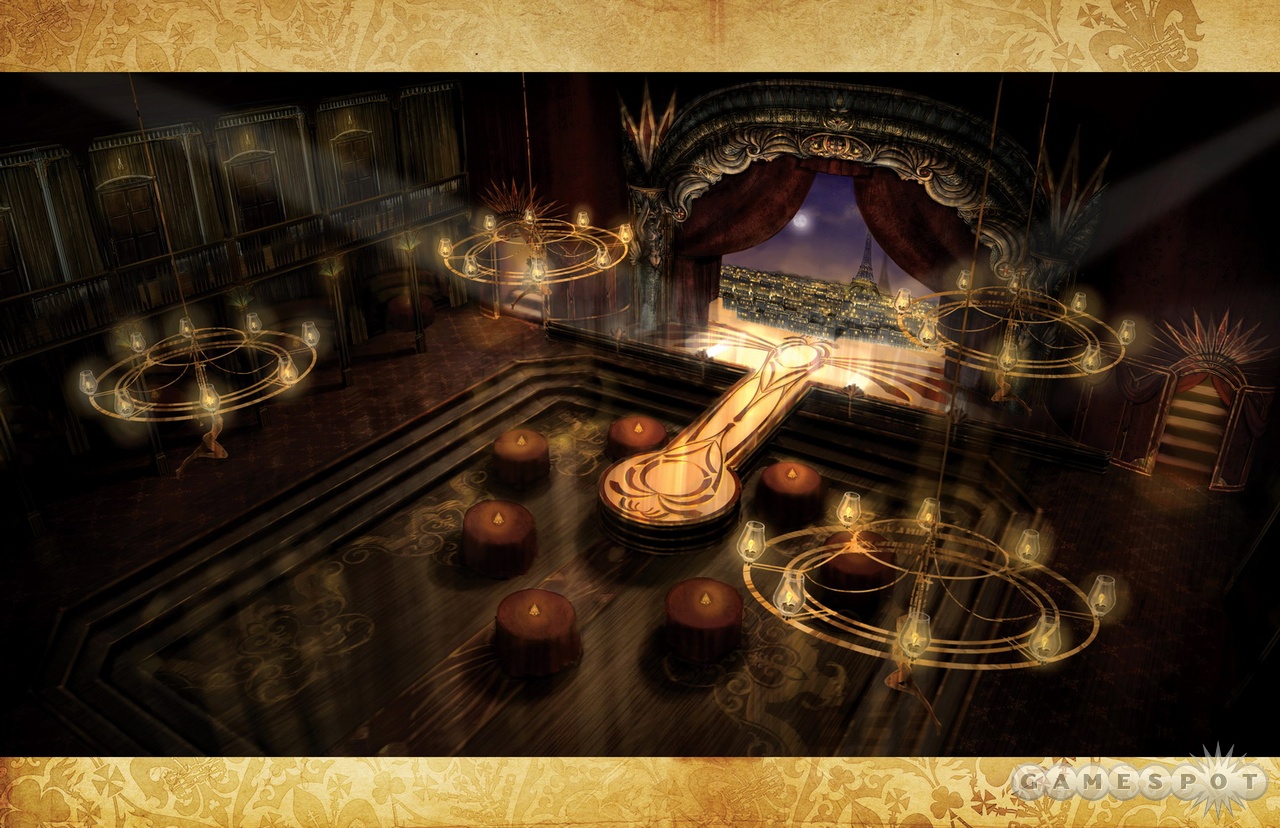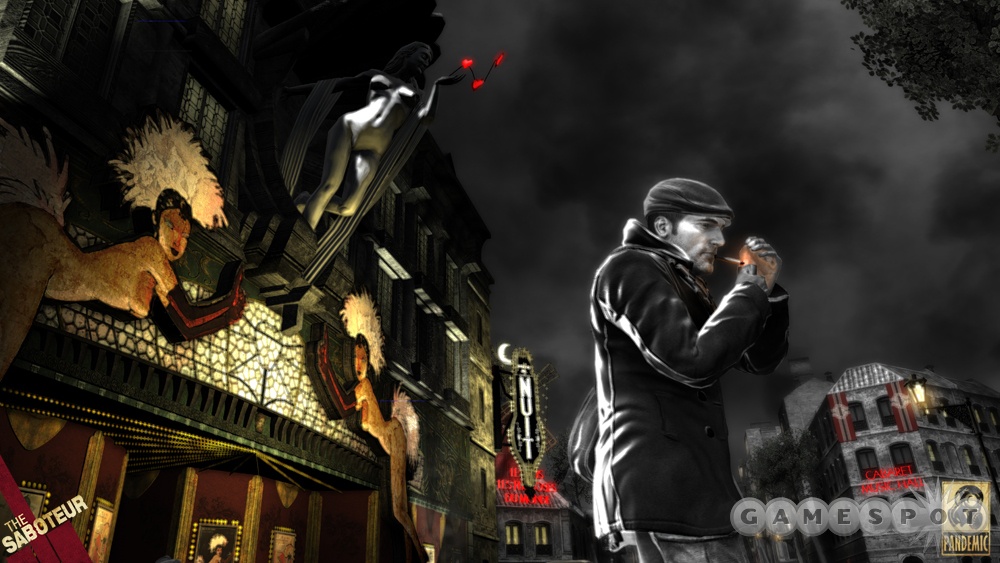The Saboteur Q&A
We talk to Pandemic art director Chris Hunt about the sights and sounds of 1940s Paris.
Later this year, Pandemic Studios will look to show that there's still room for creativity in the World War II genre when it releases The Saboteur, an open-world action game set in Nazi-occupied Paris. Perhaps no feature is more unique than the game's overall look, which begins in black and white and then slowly fills in with color as you restore civilian morale throughout Paris and a few other European locales. We recently spoke with art director Chris Hunt to get a few creative insights into the development and settings, as well as look at protagonist Sean Devlin's hideout, the Belle de Nuit.
Fallout 4 Next Gen Update Comparison Stellar Blade - 13 Things I Wish I Knew S.T.A.L.K.E.R. 2: Heart of Chornobyl — Official "Not a Paradise" Trailer Sea of Thieves Season 12: Official Content Update Video Manor Lords - Official Medieval City Builder/RTS Launch Trailer Devil May Cry: Peak Of Combat | Dante: Blazing Tempest Gameplay Trailer Honkai: Star Rail - "Then Wake to Weep" | Version 2.2 Trailer SAND LAND — Official Launch Trailer Stellar Blade - Hard Mode No Damage Gigas Boss Gameplay Stellar Blade - Hard Mode No Damage Abaddon Boss Gameplay Stellar Blade - (Almost) All Outfits Granblue Fantasy: Relink - New Content Trailer
Please enter your date of birth to view this video
By clicking 'enter', you agree to GameSpot's
Terms of Use and Privacy Policy
GameSpot: How did you arrive at the decision to set The Saboteur in Paris? Did you look at any other European cities early on in the creative stage?
Chris Hunt: France was always a central location in The Saboteur because of the inspirational foundation of our story and hero. Our real-life inspiration, William Grover-Williams of French-British heritage lived in France when he conducted espionage against the Nazis for Britain. We considered using other metropolitan centers in France in addition to Paris. Ultimately, we realized that we were going to spread ourselves too thin creating too many cities, and Paris by itself [was] very daunting to build on its own. It's such a vibrant and interesting city that we knew [it] would make a great and exciting open world for a game. Therefore, we concentrated our efforts on Paris [and] a few other key locations that worked more closely with the storyline. Aside from Paris, there is lots of French countryside, the coastal town of LeHavre to the north, and Saarbrucken on the German side of the border to the east.
GS: What were the various advantages and disadvantages you faced early on in using a city where so few other games have been set?
CH: The main advantage is that we could break new ground building a city that gamers were not familiar with. Paris offered lots of potential [and] gave us wide latitude for creative freedom. However, nothing has been done previously to compare our goals with other than the real city. We couldn't say "This other game created Paris with less geometry, so we will add two to three times as much in ours." One unique situation we had to overcome is that Paris is not laid out like most American cities with a grid system. It has a large river snaking through it along with five to eight-way intersections! This was a challenge, but we developed several innovative solutions to deal with issues like these, and now, when you drive or climb through the city, it really gives you an amazing feeling while playing the game.
GS: Can you describe the processes you went through early on in researching the overall look and feel of both Paris and the game's other various locales?
CH: Early development for The Saboteur was a combination [of ] painstaking research, concept development, and eventually a trip to France. It was important for us to re-create as much of the breathtaking architecture, countryside towns, and landmarks as possible. Our most challenging aspect for developing the visual style for the game was the black-and-white versus color look for the "Will to Fight." This required a great deal [of] art conceptualization, 2D/3D prototypes, camera work, and graphics support from engineering to achieve the visual fidelity we set out to accomplish.
GS: As an art director, how much does your job change working on an open-world game like The Saboteur compared to a game with a linear series of levels? How is the creative process impacted knowing the player can go anywhere on the map?
CH: Working on an open world is all about allocating your resources wisely! It's like having a "budget" of money you can spend on the weekend. If you spend too much money on Friday night, you won't have enough left Saturday and Sunday. You have to constantly balance the visual quality with what you show onscreen so the game will run optimally and not slow down performance. You consistently have to make calculated decisions on how to balance geometry, texture memory, collision, physics, special effects, and animation data. It's quite a task to make sure the player can enjoy a great amount of detail in the things that surround him immediately and at the same time be able to climb on a rooftop and see all the way across the city and see the countryside. Our proprietary Odin engine uses a special occlusion system, which manages how objects are rendered based on distance. So when the player is standing in front of a building, it only renders what's viewable but not the buildings behind those in front. This saves a lot of memory and allowed us to get more detail into the world.
GS: One location in the game where the player is going to spend a lot of time is Sean Devlin's hideout, the Belle de Nuit. Can you describe what sort of establishment this is and why you decided to use it as a safe house rather than an isolated apartment like a lot of sandbox action games?
CH: The Belle De Nuit is one of those essential concepts and locations of that era since Paris was really the Las Vegas of Europe during that time. The idea for the Belle actually evolved from several locations. The art team wanted a sexy cabaret, a place to showcase burlesque acts and dancers. The designers wanted a seedy dive bar where the French Resistance could meet and scheme. And, there also had to be a place where the Nazis and French could be on neutral ground under the same roof at the same time without sparking confrontations. As the story and design became more solidified, these elements merged into a single location that could serve all of these functions simultaneously.
GS: What sort of inspirations did you use in designing the look of the Belle? How much of those were real-life locations and how much were movies and books?
CH: We began looking at traditional places in Paris for inspiration, such as the Moulin Rouge and Le Lido de Paris. Another strong influence was "Rick's Cafe Americain" from the classic film Casablanca. However, given the multiple roles the establishment would serve, we decided we needed to put our own touch on the building. We knew we wanted the Belle to have seen better days; it had to be old but still functional. The architecture had to be filled with 1920s art nouveau decor inside and out. The space also had to be large enough for show performances, for patrons to sit or walk around, and to house private areas that could be kept hidden from the Nazis. From here, the art team got started with preliminary design work.
GS: How did you go about trying to capture the sights and sounds of 1940s Paris nightlife? How important was it to reflect the tense atmosphere of Parisians trying to have fun under strict Nazi control?
CH: Historically, Paris had a legendary nightlife, so there was an infinite amount of information to draw from. Ironically, showing this aspect of Parisian life during the 1940s is crucial to enhancing the sharp contrast of the Nazi occupation of the city; what we call "Low Will to Fight." The nightlife is on the other side of the coin of the Nazi control in The Saboteur. Players will definitely notice the effort that was put [in] re-creating Parisian nightlife once they play the game on December 8.
Got a news tip or want to contact us directly? Email news@gamespot.com


Join the conversation